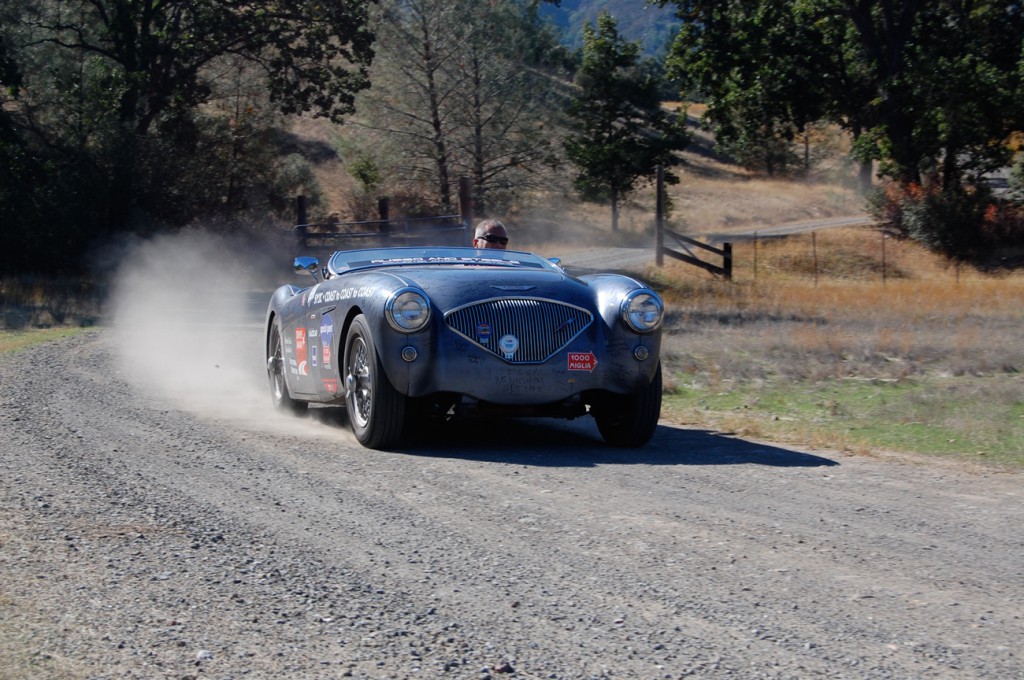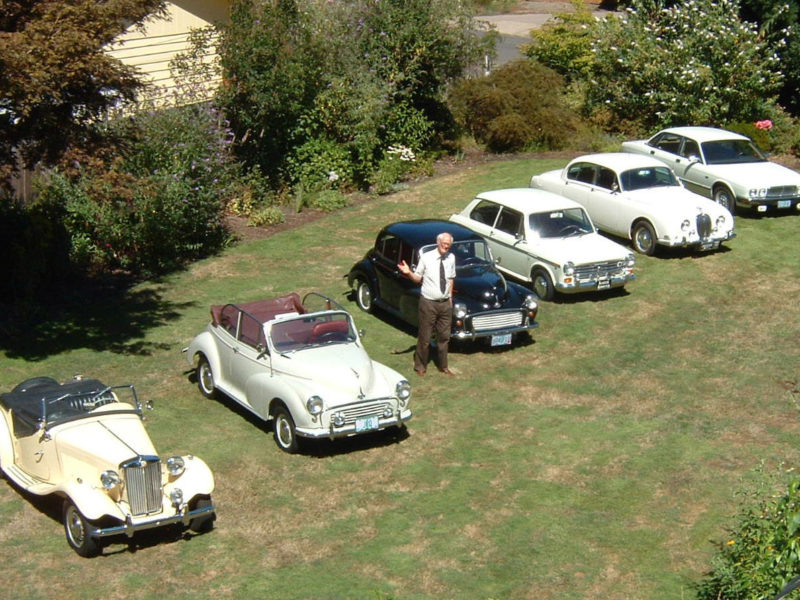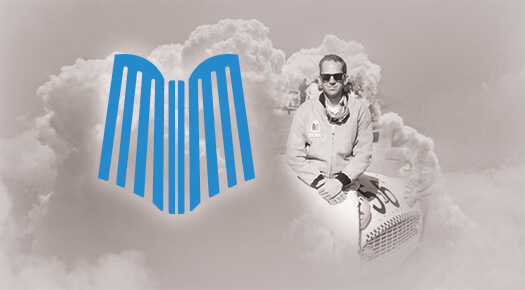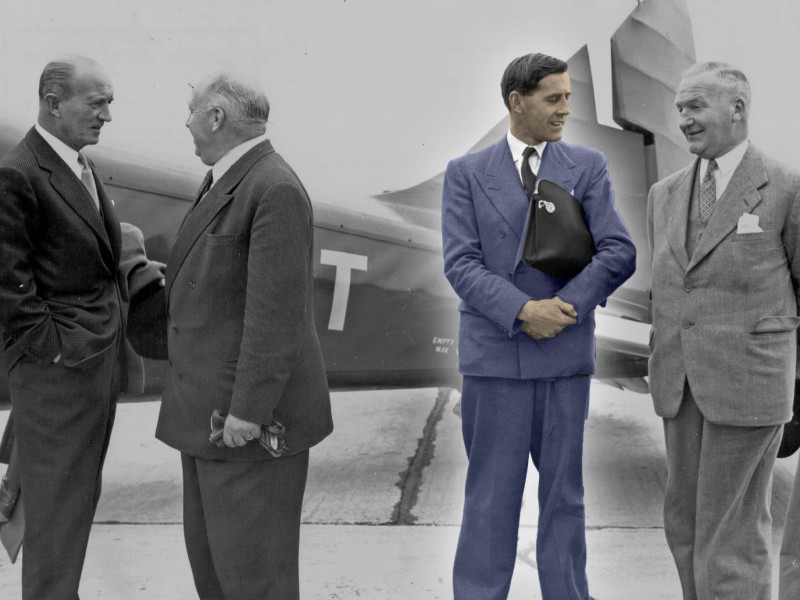What we have done for ourselves alone dies with us; what we have done for others and the world remains and is immortal – Albert Pike
Riding along on the highway, I look over at the driver seated next to me as the airflow over the retracted windscreen deforms his cheeks into undulating waves of flesh. I think to myself, “we must look pretty silly,” but find it hard to suppress an ever-increasing grin. What John Nikas is doing is ridiculous – it just doesn’t make any sense. Perhaps therein lies the beauty of the entire hare brained adventure.
John is driving like a bat out of hell all over the country in a sad, rust shot, heap of an Austin Healey. And with every mile, every too frequent stop for makeshift repairs, he’s throwing a punch at a terrible disease that impacts everyone.
Cancer creates in us a feeling of powerlessness, a loss of control. It is a heavy burden that can be so hard to talk about. But in this life we are not alone. It is during desperate moments that we truly need to experience life and savor the things that are important, like family, loved ones—or simple pleasures like driving.
Let me add a comment to that last thought. As readers of this magazine well know, the pleasure of driving obsolescent British sports cars is rarely simple. Sometimes a successful drive feels like an act of mercy – or contrition for letting a once trusty mount waste away from disuse. This is a story of that kind of drive.
Something to do
In the midst of a summer of normal activity for the Austin-Healey Association of Southern California, one of its members, Mike Newsome, was diagnosed with multiple myeloma. John is his close friend and had borrowed Mike’s derelict 1953 100 with the understanding that he help resurrect it after decades of neglect and disuse. The Healey had been purchased from eBay sight unseen from the salt laden roads of Michigan, the kind that should model as a buyer-beware poster child. The week following Mike’s diagnosis John decided he had to do something. More of an impulse than a plan, a whirlwind drive around the country with the Healey was conceived to show that no matter the difficulties faced it was important to just keep going.
When asked to describe the condition of the car, John wrote “she smoked like a convict on death row, leaked oil like a holed tanker and had the reliability of an auto plant worker on the day after an all night bender.” The description, however colorful, could not do justice to the mechanical demons plaguing the car. Rust had eaten away the cross members so severely that an attempt to pull the engine was deemed unsafe lest the frame collapse upon itself without the motor for support. Oil pressure at speed was a tick less than 20 pounds and almost every attached part that could fall off abandoned the car like an unscrupulous First Class passenger on the Titanic facing a dearth of lifeboat seats.
Despite the many problems that the Healey was cursed with she was equally blessed with an amazing sense of perseverance that would serve her well on her journey. On the day before the start of the long drive she was bestowed with a decidedly heavenly name – Grace. And if you follow along with John’s travels, you’ll see there could be no better moniker, both for the near-supernatural help required to keep her going but also for the way in which she touched the people she encountered on the road.
Coast-to-coast and back again
Over the course of eight days John and his friends from the Healey club worked to make roadworthy a car that hadn’t made a successful trip in decades, essentially wrapping bandages over critical wounds. For John’s scheme to work there wasn’t time to do much else. The plan was simple and epic: Drive from the Pacific Ocean to the Atlantic Ocean and back with the support of as many British car clubs as possible while raising awareness and money for cancer research. Despite tempting enormous odds of failure or catastrophic disaster, the finish line would be the main-stage at the acclaimed Russo & Steele Auction in Monterey, California, after nearly two weeks of virtually non-stop driving. Many, including myself, would have lost money had we placed our bets, with the smart money wagering that he would not make it past the first day.
What any observer would have noticed surveying the Healey (painted a metallic gray straight out of a rattle can) as it sat perched on the far end of the Huntington Beach Pier before the start of the trip would undoubtedly have been the oil already starting to escape from captivity within the engine and the daylight visible through body panels eaten away by rust. But a discerning eye would also have noticed the scribble of black ink on the rear deck lid next to more than a dozen names printed in white vinyl. The day before, John had the names of family and friends laser cut and placed on the trunk to remind him of the people in his own life affected by cancer. But as his friend, Mike Newsome, made his way down the pier to see his car make the start of the trip, John realized a horrible error. In the rush to get the car running he had forgotten to cut vinyl for him! Thinking quickly, he pulled out a Sharpie as Newsome looked for his name and handed it to him asking, “I wanted your name to be signed in person.”
This simple, makeshift solution, would prove over the next two weeks to become a touching – and often heart rending – phenomena that took on a life of its own. That morning on the pier, under an overcast sky, as passersby stopped to enquire what was going on, as Newsome and other friends inscribed additional names, they too asked if they could remember others by writing on the decrepit little car. By the time that John pressed the starter button and left with a police escort heading for the rising sun, dozens of additional names had been inscribed in telltale black ink to join him on the trip.
John’s cross-country trip could (and should) have ended in every state he drove through. Over the course of 7,241 miles the car suffered through two gas fed fires, used over 260 quarts of oil and drove through rain, hail, thunderstorms and record heat—all without benefit of a top or side curtains for protection. Seven roadside repairs and an on-the-fly engine rebuild saw the car through to Monterey. He called mechanic friends saying, “The oil pressure gauge is reading 3-lbs, should I keep going?” They’d shrug and say keep feeding her oil and roll the dice. There was no temporary fix that would work; Grace needed total restoration or at least an engine rebuild, but she would have to wait.
As John traveled across America, he would have to make frequent stops—for drinking water, since plastic bottles melted in the sweltering cockpit heat (exacerbated by a lack of carpeting, triple digit ambient temperatures and a gaping hole in the firewall) leaking their contents over the broiling floorboards—and always, constantly, for more oil. Those following John’s progress on the Internet read plaintive missives from a driver behind the wheel of a car about to enter its final death throes: “Cockpit filling with smoke. Visibility impaired. Pressing on.”
At just about every stop (you can’t blame one woman for hustling away from the car as flames leapt out from the hood, as she stood, mouth agape, from the adjacent gas pump) perfect strangers would ask about the hand written inscriptions on the car. Invariably they would have their own stories to share about their own experience with an illness that seemingly has left no family unscathed. One man in North Carolina surveyed the car, appraised the signatures and reviewed the graphics that stated simply – Drive Away Cancer, and pulled from his wallet a photo of his wife, who had lost her own battle to the disease, explaining that he had always promised to take her to California. He looked at John and asked if he would take her there for him
and handed over the creased picture with tears in his eyes. Hands trembling, John taped it to the dash. It is there still.
Grace now carries several thousand names of people who fight cancer today, have beaten it in the past or been lost to the illness forever. John always has two Sharpie pens on him so that the makeshift memorial is an ever-changing monument to those loved – and remembered. I, myself, won’t let out of my mind the inscription that reads: “Dad, you would’ve loved this,” or the writing with an arrow pointing to the right headlight: “To my brother, you lit the way.” Some of the names come from the unsteady hands of young children; some are the pen strokes of best friends, siblings, mothers and fathers, sons and daughters. Grace is an embodiment of the pain of living and dying we can’t avoid. And, she is a reflection of the love that enables us to persevere, push on and survive
British family
When John began his drive, one of the greatest assets he knew he could lean on was the willingness to help and unwavering support of British car owners everywhere. “They are all family,” he said to me, “they kind of have to be. We couldn’t drive these cars if we couldn’t count on getting a lot of help.”
A complete stranger and owner of an MGB and Healey 100-6, Todd Schelling, saw John on his local evening news and met him at a gas station near Columbia, South Carolina with a trunk full of oil, several bottles of STP and escorted him to the Atlantic Ocean to make sure he had someone there to share the achievement of having made it halfway.
On the return trip to Monterey, having coasted to a stop at an abandoned gas station in the Texas Panhandle, John sat slumped with an engine silenced by a spun rod bearing and typed this Facebook posting into his phone: “Every breath wounds and the last one kills. This poor, tired, neglected car with the rotted body and weak heart gave everything she had for mile after mile. I’m sorry I failed. I tried as hard as I could to make it but she had nothing left to give. We almost made it …”
The next day, amid a dozen consolatory comments, a 100M owner named Judy Wrobel wrote, “You haven’t failed yet. Just possibly you’ll be late for your appointment!” Judy had a trailer, and with her trusted mechanic in tow, David Porter, drove 400 miles to pick up John and Grace and bring them to sanctuary in Albuquerque, New Mexico. David worked unt
il early the next day to perform an emergency rebuild of the bottom end using bearings and an oil pump which had been shipped overnight by cancer survivor David Nock, who had lost his own father, Norman Nock (who founded British Car Specialists in 1957) to cancer the year before.
Asking for or receiving help is not an indicator of failure. Just ask anyone who is dealing with cancer. Grace made it to Monterey against all odds, but not without the support from untold thousands who either helped directly or offered kind wishes from afar. Ultimately, Grace became the perfect metaphor for people affected by cancer: hindered, impaired, damaged, but still capable of amazing feats. John explains: “We could have made the trip in a well sorted car without trouble. Hell, we could have rented a Camry and done it with both eyes closed. But to have actually made it in a car that hadn’t run in years, with a failing engine and a rotted body, that says something about carrying on in the face of adversity. The fact that we made it means that anyone else can too. Sometimes we don’t have the luxury of going forward when things are great; sometimes we have to press on when things are falling apart – physically, emotionally or financially. The key is to press on regardless – even when the night is dark, the wind is cold and the oil pressure is falling into the single digits.”
Most of the time John is alone with Grace, but people across the country and all around the world still follow their adventures and embrace their message of remembrance, hope and survival. John drives every mile with the windscreen lowered through heat, cold, rain, hail and snow. At speed, the wind noise is deafening and the buffeting akin to being shaken repeatedly by unseen hands. “I do it for those who can no longer feel the wind on their face,” he says. “As long as I’m driving, I know I’m alive.”
Victory
On October 29, 2011, Grace was the first car to cross the finish line of the inaugural Mille Miglia North America Tribute—a 1000-mile open road endurance race featuring Ferraris, Maseratis, Alfa Romeos, Lancias and other high value cars. Driver John Nikas and Navigators Andy Reid (Editor at Classic Motorsports) and Todd Schelling (the stranger from South Carolina) swept all seven segments of the race outright, competing against multi-million dollar, specially prepared vintage and historic racecars. In addition to the overall win, their fellow competitors recognized Grace and John with the Participant’s Choice Award. Read the full story on this site by searching “Mille Miglia”
Join the Drive
From February to August, Drive Away Cancer will be traveling to all 50 states. If you or your car club would like to participate in the journey, add a name to Grace, or just say hello to John, please write to info@driveawaycancernow.org, visit the website at driveawaycancernow.org or check out what’s new at facebook.com/driveawaycancernow
By David Stuursma












'Saving Grace – Driving to stop cancer in its tracks' have 2 comments
December 14, 2012 @ 9:55 am Judy Wheeler
Just reread your Jan 2012 article about Grace and John after having the priviledge of accompanying Ginger and Syn to Sherman, TX to visit a scared young boy facing brain surgery due to cancer. Seeing his huge smiles while in Ginger, and his joy while driving her, and then seeing what his smiles did for his family was unbelievable. It made me fully understand why John began his quest and why others in various states have joined John in his quest to further spread the message of “never give up.” As I type Ginger is having more surgery this afternoon to see if they can figure out at least part of what ails her so she can get back on the road. I just hope Syn lets me go with her as navigator on future visits.
December 14, 2012 @ 1:50 pm Kris Decklever
I was fortunate enough to be able to help Syn and Ginger while they were on layover here in central Iowa and will hopefully be involved in getting Grace back underway as well. I have been lucky enough to have had only minimal contact with this horrible disease in my life so far, and this story still brings tears to my eyes.